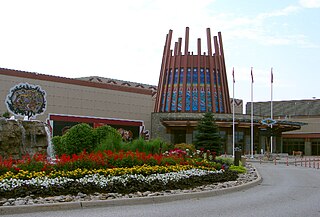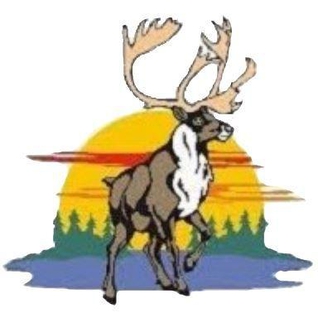The Cree are a North American Indigenous people. They live primarily in Canada, where they form one of that country's largest First Nations.

The Mississauga are a subtribe of the Anishinaabe-speaking First Nations peoples located in southern Ontario, Canada. They are closely related to the Ojibwe. The name "Mississauga" comes from the Anishinaabe word Misi-zaagiing, meaning "[Those at the] Great River-mouth." It is closely related to the Ojibwe word Misswezahging, which means ‘a river with many outlets.’

Curve Lake First Nation 35 is an Ojibwe Native reserve 14 km north of Peterborough, Ontario. It serves as the landbase for the Curve Lake First Nation. The reserve occupies a peninsula located between Lake Chemong and Buckhorn Lake, surrounded by the township of Selwyn, as well as several neighbouring small islands in Buckhorn Lake.

Islands in the Trent Waters 36A is a First Nations reserve about 15 kilometres north of Peterborough, Ontario, Canada, on scattered islands in the Kawartha lakes, including Buckhorn Lake, Pigeon Lake, Lower Buckhorn Lake, Lovesick Lake and Stony Lake. The largest concentration of such islands are in Lower Buckhorn and Lovesick Lakes. It is inhabited, mainly seasonally, by members of the Curve Lake, Hiawatha, and Scugog First Nations, who jointly share it.

The Chippewas of Georgina Island First Nation are an Ojibwa people located on Georgina Island in Lake Simcoe, Ontario, Canada. In 2008, of the First Nation's registered population of 666 people, 181 lived on, and 485 lived outside, their reserve. As of 2020, the band has a total population of 923 members. They are one of a handful of First Nations in the Toronto Census Metropolitan Area.

Curve Lake First Nation is a Mississauga Ojibway First Nation located in Peterborough County of Ontario. Curve Lake First Nation occupies three reserves; Curve Lake First Nation 35, Curve Lake 35A, and Islands in the Trent Waters Indian Reserve 36A. The last of these reserves is shared with the Hiawatha First Nation and the Scugog First Nation. Curve Lake First Nation has a registered membership of 2,415 as of October 2019 with 793 registered band members living in Curve Lake and an additional 1,622 registered band members living off-reserve.

Chippewas of Rama First Nation, also known as Chippewas of Mnjikaning and Chippewas of Rama Mnjikaning First Nation, is an Anishinaabe (Ojibway) First Nation located in the province of Ontario in Canada. The name Mnjikaning, or fully vocalized as Minjikaning, refers to the fishing weirs at Atherley Narrows between Lake Simcoe and Lake Couchiching and it means "in/on/at or near the fence".

Lac Seul First Nation is an Ojibwe First Nation band government located on the southeastern shores of Lac Seul, 56 kilometres (35 mi) northeast of the city of Dryden, Ontario. Though Lac Seul First Nation is a treaty signatory to Treaty 3, the First Nation is a member of the Independent First Nations Alliance, a regional tribal council and a member of the Nishnawbe Aski Nation.
Fishing Lake First Nation is a First Nation of the Saulteaux branch of the Ojibwe nation. The band can trace their origins to central Canada, and were pushed westward to avoid encroachment by European settlers. The First Nation was originally part of the Yellow-quill Saulteaux Band, a Treaty Band named after a Treaty 4 signatory Chief Ošāwaškokwanēpi, whose name means "Green/Blue-quill." However, due to "š" merging with "s" in Nakawēmowin, this led to a mistranslation of his name as "Yellow-quill"—"yellow" being osāw-, while "green/blue" being ošāwaško-. The band was given three reserves, at Fishing and Nut Lakes and Kinistino, Saskatchewan. The Fishing Lake Indian Reserve 89 was approximately 22,850 acres (92.5 km2). Soon after the death of Chief Ošāwaškokwanēpi, the Band divided into three groups, the Fishing Lake First Nation, the Yellow Quill First Nation, and the Kinistin Saulteaux Nation

Hatchet Lake Denesuline Nation is a Denesuline First Nation in northern Saskatchewan. The main settlement, Wollaston Lake, is an unincorporated community on Wollaston Lake in the boreal forest of north-eastern Saskatchewan, Canada.
Pinaymootang First Nation is a First Nations people whose home location is on Fairford 50 Reserve at Fairford, Manitoba, Canada. They are situated on Hwy #6 in the Interlake Region of Manitoba about 220 kilometres from Winnipeg. The Rural Municipality of Grahamdale forms most of the reserve's land boundary, although it also has a short border with the Little Saskatchewan First Nation as well as significant lakeshore on Lake St. Martin, which is considered as being outside the reserve. The main settlement on the reserve is located at 51°35′55″N98°41′32″W.

The English River Dene Nation is a Dene First Nation band government in Patuanak, Saskatchewan, Canada. Their reserve is in the northern section of this Canadian province. Its territories are in the boreal forest of the Canadian Shield. This First Nation is a member of the Meadow Lake Tribal Council (MLTC).

Elsie Marie Knott was the first woman in Canada to be elected as Chief of a First Nation. Knott became Chief of the Curve Lake First Nation in 1954, three years after the Indian Act was amended to give First Nations women the right to vote and hold positions in band governments.
With Elsie, the difficult was easy, the impossible took a little longer.

Lake of the Woods 35J is a First Nations reserve in Kenora District, Ontario. It consists of Comegan Island, Sanguishii-aagaamiing Island and Sanguishii-aagaamiising Island in Lake of the Woods, and is one of the reserves of the Big Grassy First Nation.

Naongashing 35A is a First Nations reserve on Aulneau Island in Lake of the Woods in Ontario. It is one of the reserves of the Big Grassy First Nation.

Obabikong 35B is a First Nations reserve on Aulneau Island in Lake of the Woods, Ontario. It is one of the reserves of the Big Grassy First Nation.
Big Island Lake Cree Nation is a Cree First Nation in Saskatchewan, Canada. They have reserved for themselves one reserve, also called Big Island Lake Cree Nation, within Rural Municipality of Beaver River No. 622.








